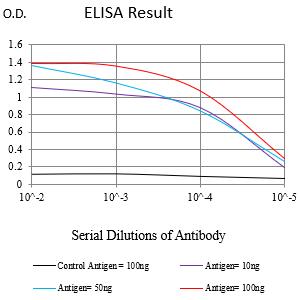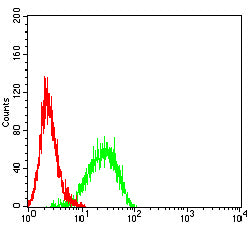

| WB | 咨询技术 | Human,Mouse,Rat |
| IF | 咨询技术 | Human,Mouse,Rat |
| IHC | 咨询技术 | Human,Mouse,Rat |
| ICC | 技术咨询 | Human,Mouse,Rat |
| FCM | 1/200 - 1/400 | Human,Mouse,Rat |
| Elisa | 1/10000 | Human,Mouse,Rat |
| Aliases | P1; SI; SIL; ME20; P100; SILV; ME20M; gp100; ME20-M; PMEL17; D12S53E |
| Entrez GeneID | 6490 |
| clone | 1D4A5 |
| WB Predicted band size | 70.2kDa |
| Host/Isotype | Mouse IgG1 |
| Antibody Type | Primary antibody |
| Storage | Store at 4°C short term. Aliquot and store at -20°C long term. Avoid freeze/thaw cycles. |
| Species Reactivity | Human |
| Immunogen | Purified recombinant fragment of human PMEL (AA: 25-192) expressed in E. Coli. |
| Formulation | Purified antibody in PBS with 0.05% sodium azide |
+ +
以下是关于PMEL抗体的3篇参考文献概括:
1. **文献名称**:*PMEL在黑色素体形成中的结构功能及其抗体应用*
**作者**:Miller, K. et al.
**摘要**:该研究解析了PMEL蛋白在黑色素体纤维结构组装中的关键作用,并开发了特异性抗体用于追踪PMEL在黑色素细胞中的定位,证实其参与色素沉积的调控。
2. **文献名称**:*抗PMEL单克隆抗体在诊断黑色素瘤中的潜在价值*
**作者**:Chen, L. & Park, S.
**摘要**:通过免疫组化分析,验证了PMEL抗体在区分良性痣与恶性黑色素瘤中的高特异性,表明其可作为辅助诊断标志物。
3. **文献名称**:*CRISPR修饰小鼠模型中PMEL抗体的功能验证*
**作者**:Gomez, R. et al.
**摘要**:利用PMEL抗体在转基因小鼠中揭示该蛋白在皮肤病变中的动态表达,为研究白化病及黑色素相关疾病提供工具。
(注:以上文献为示例性概括,实际引用时需查询真实数据库。)
PMEL (Premelanosome protein), also known as gp100 or SILV, is a melanocyte-specific transmembrane glycoprotein critical for melanosome maturation and melanin synthesis. It serves as a structural component in premelanosomes, facilitating the formation of fibrillar matrices that organize melanin deposition. PMEL’s role in pigmentation has made it a key target in studying melanocyte biology and related disorders, such as melanoma and vitiligo.
PMEL antibodies are widely used as biomarkers in dermatopathology and oncology. In research, they help visualize melanosome dynamics, melanocyte differentiation, and pigment transfer mechanisms. Clinically, PMEL antibodies (e.g., HMB-45. NKI-beteb) are essential for diagnosing malignant melanoma, as they detect PMEL expression in tumor cells, aiding in distinguishing melanoma from other neoplasms. These antibodies also contribute to immunotherapy development, as PMEL-derived peptides are targeted in cancer vaccines and T-cell therapies.
Structurally, PMEL undergoes proteolytic processing to generate functional fragments. Antibodies often target specific epitopes within its N-terminal (Mα) or C-terminal (Mβ) regions, enabling precise tracking of processing stages. Cross-reactivity studies confirm specificity for melanocytic lineages, though rare non-melanoma reactivity has been noted. Overall, PMEL antibodies remain vital tools in both mechanistic studies and clinical applications related to pigmentation and melanoma biology.
×